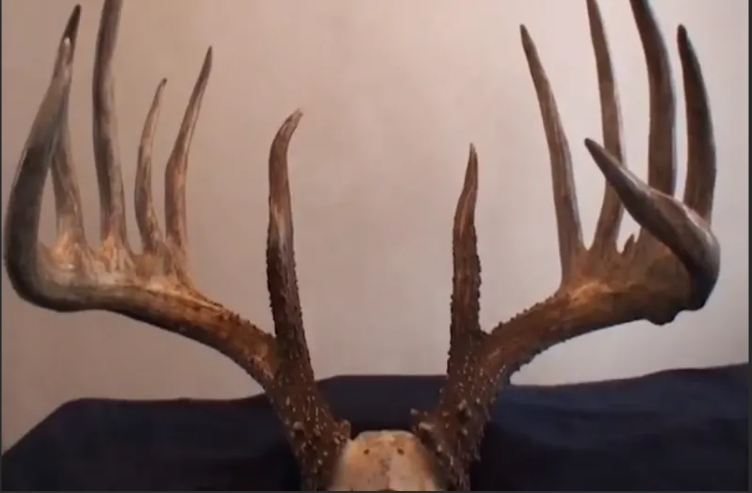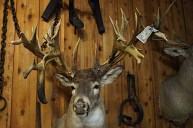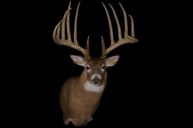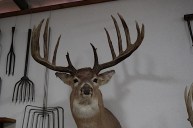In the world of whitetail deer hunting, the typical whitetail world record is the pipe dream aspiration for many hunters. It's the pinnacle, the top of the mountain, and the ultimate symbol of success. Many whitetail deer hunters will never come close to reaching it, but for those who do, it can be a hotly debated contest. The current world record has been held for 30 years by Saskatchewan farmer Milo Hanson, who leveled his 213 5/8-inch monster back in 1993. Since then, the big Canadian buck has defended the throne against all new challengers, season after season.
In 2006, a new contender entered the scene, and it looked as if a new world record would be declared.
A huge, 12-point from Grant County, Wisconsin, had been shot by a man named Johnny King, sending the whitetail world into a frenzy. The excitement of a new typical world record soon spiraled into controversy when the buck's final net typical score was revealed. Boone and Crockett's scorers had determined that not only was the Johnny King buck not a new world record, but it did also not even crack the top 10 for whitetail deer in the Boone and Crockett Club's record books.
This decision kicked off a flurry of disagreement among hunters, with some accepting the scorers' decision and others hotly debating it. To this day, some 17 years later, one mention of the Johnny King buck sends many hunters into a huff. So, how did the scorers make their determination? To understand that decision, the story must start with the hunt.
The Hunt That Almost Broke the Record
The fateful day was Nov. 18, 2006, opening morning of the Wisconsin firearms season, when Johnny King would bag a world-class whitetail that would lead to years of controversy. On this day, King was hunting with his brother, some cousins, and two uncles. The morning sit proved a total bust, but the family regrouped at midday for a deer drive on a different property.
Normally on a drive like this, King would act as a pusher, sending deer to others. On this day, as fate would have it, his brother suggested that he be a sitter instead. King picked out a spot next to a telephone pole and sat down to wait. Before the drive had officially begun, a mammoth buck suddenly made an appearance, coming in behind King and running in the direction of the pushers. King only saw the animal a few seconds before it disappeared into a draw in the direction of one of his uncles. His uncle sent a bullet at it but missed.
Eventually, Johnny spotted the buck again in some thick brush approximately 150 yards out. He steadied the rifle—an old Springfield Arms .30-30—on his knees and squeezed off a round. The deer immediately stumbled backward, indicating it was hit. There was another large draw in the area, and King did not want the buck to vanish on the other side of it, so he began crawling and following, looking up periodically to look for the buck. He managed to get a couple more shots off, but the buck was still going. Eventually, King reached a fence and got up to look one more time for the deer, knowing this was probably his last chance at it. The buck stood up in front of him, and he took another shot. The buck immediately disappeared.
King went to the top of the draw and saw no signs of the buck. He could see the deer drive starting off in the distance, though. He realized he would have to wait for the drive to end because the drivers could not hear his yells. While he was standing there, the buck suddenly came back out of the woods and began walking right at King. He took another shot and ran to the spot where the deer had been standing, only to see him run away. King took yet another shot—which, unknown to him at the time, went through the main beam of the buck's left antler.
At this point the buck was hurt badly, but it still was not dead. And King realized he had lost the rest of his bullets through a hole in his hunting clothes. King yelled to his cousin Brad, who was finally on the scene. One shot later, and the deer dropped. King's cousin went to lift its head and it reared up, and they realized it wasn't yet dead. At the same time, the buck's rack broke at the spot King had hit it earlier. The hunters had to put one more round in the deer to finally put him down for good.
The King family does not run trail cameras, so they had no idea a buck of this caliber was even on the property. News spread quickly about the deer's harvest. Little did King know the wild hunt was just the beginning of the story.
The Controversy Swirls
Although King knew the buck was huge, he did not realize the magnitude of the deer's size until several weeks later, when he took it to a local scorer who told him the deer could be a new world record. The local scorer then put King in contact with a Boone and Crocket Club scorer. The biggest concern after the hunt was about the break in the deer's antler. Prior to 2006, several major scoring organizations had been rather reluctant to measure world-class deer with breaks in their antlers.
In an interview with Big Buck Registry, King noted he had not really shown the deer to anyone when Boone and Crockett scorers finally came to his house to look at the rack in January 2007. The scorers were impressed. The main beams are 29 inches, many of the tines are 10 to 11 inches, the inside spread is 21 inches, and it has mass measurements of nearly 6 inches. The antlers are impressively huge.
King was advised to bring the antlers to a hunting show to have it looked at more closely by Boone and Crockett. A few months later, in April, King loaded the rack into a vehicle and drove 1,200 miles to Pennsylvania for a Pope and Young National Convention. Boone and Crockett scorers were at the event who would then examine the break to determine eligibility into B&C's record books.
This is when things got serious.
There, the scorers—including B&C's director of Big Game Records, Jack Reneau—examined the King buck for more than an hour privately in a room while King waited outside. When they called King back into the room, they had both good news and bad news. The good news was the buck was eligible for measurement and entry into the B&C scoring system. The bad news was it was not a world record.
An Unusual Ruling
The big controversy with this deer comes down to the animal's G3 tine on the right side. B&C determined the buck's G3 tine was a non-typical point because the G3 and G2 shared a common base. That meant the buck could not be scored as a 6x6. When explaining the situation, the scorers told King there was no point sending the deer to a B&C panel score session because the measurers there would determine the buck could only be scored as a typical 5x5 because the G3 and circumference measurements would be deducted on both sides. King was disappointed but made the long drive back to Wisconsin with his buck to have it measured by a local scorer.
The original measurer, who had first directed King to contact B&C, then scored the buck and came up with a net score of 180 inches. A massive deer to be sure, but it was far below the measurer's initial measurements of nearly 224 inches gross and 218 inches net. The measurer offered King the chance to enter it as a non-typical, which would have pushed the score to over 220 inches, but King was not interested.
A Second Rejection
By this point, word about the King buck was out, and many hunters across North America were in disbelief that the Hanson buck was still on top after B&C's ruling. King decided he was done with it at this point, and the buck was entered into the books with the 180-inch score. That may have been the end of the story, but King was still looking for someone to repair the antlers. He took it to a deer show shortly after that, which is where he met taxidermist Jay Fish. He ends up being the key figure in this story because Fish referred King to a man who could repair the antlers. He also knew an official measurer for Buckmasters and helped set up another scoring session. It is worth noting that Buckmasters does not do deductions or give inside spread credit in its system.
The buck was re-measured by a Buckmasters scorer at 198 2/8 inches, which was enough for the deer to become the new world record in Buckmasters' "perfect" category. After that, King took the buck home and travelled to several more shows with it before ultimately deciding to sell the antlers to Fish—who had previously expressed interest in buying them—in 2010.
After buying the deer, Fish began using his resources and contacts within the hunting and big game records world to lobby to have the deer brought to a B&C panel scoring. He finally got his wish in September 2012, when two teams of judges who had not seen or scored the rack previously scored the buck at B&C's Missoula, Montana, headquarters. In the end, they came to the same conclusion Reneau had back in 2007, that the G3 was non-typical and the buck scored 180. The club elaborated more on the ruling in press release on its website.
'The panel determined the third tine on the right antler arises from the inside edge of the top of the main beam, and also arises partially from the base of an adjoining point, thus establishing it as an abnormal point," the release states. "With this confirmation, two of the rack's tines must be classified as abnormal points resulting in an entry score well below the current world's record."
Fish and King were not happy about this decision—Fish even more so than King. That's probably because Fish had taken the deer and had it certified about a year earlier as the new world record by the Northeast Big Buck Club, which uses the same scoring rules as B&C's. The scorers with that club had agreed with Fish that the buck was a 6x6 typical. However, B&C's determination was final, and the Hanson buck remains the world record. With their final decision, Eldon Buckner, the chairman of B&C's Records of North American Big Game Committee, commented:
"There's a lot of process and due diligence, and through it all, it's important to remember the chief reason why we keep records in the first place," Buckner said. "It's not to aggrandize hunters, rank individual animals or monetize trophies, but to document conservation success. I'm confident that our panel has upheld the historic integrity of our records. It's not a world's record, but the King buck is certainly a world-class specimen and another reason to celebrate the conservation work of the Wisconsin Department of Natural Resources."
The Controversy Continues
Much like the infamous "Rompola buck," controversy about the King buck rages on. Many hunters are still divided. Some believe B&C's ruling makes sense within the rules. Still others believe the deer was given a raw deal. Unless there is a major rule change in the future that opens the King buck back for reconsideration, it is likely to not ever climb to the top of B&C's record books.
One thing is for sure: Wisconsin is a legendary whitetail factory; and the King buck, much like the famous Jordan buck, will be a favorite beloved by hunters everywhere for many years to come.




